 Research Article
Research Article
Health Risk Assessment of Heavy Metals Through Six Common Spices of Mohanpur Upazila of Rajshahi District, Bangladesh
Md. Mahtab Ali Mollah1*, Md. Golam Rabbany1, M Nurunnabi2, Sha Md.Shahan Shahriar1 and Sayed M A Salam1
1Department of Applied Chemistry and Chemical Engineering, Faculty of Engineering, University of Rajshahi, Bangladesh
2Department of Applied Chemistry and Chemical Engineering, Bangabandhu Sheikh Mujibur Rahman Science and Technology University, Gopalganj, Bangladesh
Md. Mahtab Ali Mollah, Environmental Pollution Studies Laboratory, Department of Applied Chemistry and Chemical Engineering, Faculty of Engineering, University of Rajshahi, Rajshahi-6205, Bangladesh.
Received Date:July 01, 2022; Published Date:August 09, 2022
Abstract
Six types of spices samples (viz. Capsicum annuum, Allium cepa, Curcuma longa, Zingiber officinale, Allium sativum and Coriandrum sativum) were collected from Mohanpur Upazila of Rajshahi district. For the determination of heavy metals (Pb Cd, Cr and As) concentrations and human health risks, the spice samples were digested in a mixture of HNO3 and H2O2. It is observed that the average concentrations of Pb, Cd, Cr and As are varied from 0.8504 mg/kg to 1.9694 mg/kg, 0.1522 mg/kg to 1.2173 mg/kg, 0.7172 mg/kg to 1.4760 m/kg and 0.2285 mg/kg to 4.0157 mg/kg respectively. The highest concentration of As 4.0157mg/kg were investigated in Green Chili. Results indicate that Pb, Cd, Cr and As content in all spice samples are within the International standards limit. The MPI (metal pollution index) value for Green chili, Onoin, Turmeric, Ginger, Coriander and Garlic is generally low indicated heavy metal contamination and has no significant threat of negative impact on human health. THQ values of Pb, Cd, Cr and 66.67% of As in all spices were less than 1. About 66.67% of the HI values of the samples under study were less than 1. They indicate that the consumers will not experience potential health risks from the intake of individual metals through spices consumption. However, a continuous monitoring should be carried on.
Keyword:Heavy Metal; Spices; Health Risk; Oral Reference Doses
Introduction
A spice is a dried seed, fruit, root, bark, or vegetable substance primarily used for flavouring, colouring or preserving food. Sometimes a spice is used to hide other flavours. Many spices have antimicrobial properties. This may explain why spices are more commonly used in warmer climates, which have more infectious diseases, and why use of spices is especially prominent in meats, which is particularly susceptible to spoiling [1]. Natural food spices such as pepper and mustard have been reported to contain significant quantities of some trace metals [2]. Spices have played an important role in the history of civilization, exploration and commerce as these had a universal acceptance as condiment and flavours in human diet as well as in treatment of ailments. There are evidence of plant derived aromatic compounds especially spices being used by almost all ancient civilizations, the Indian, the Egyptian, the Babylonian, the Persian, the Jews, the Chinese, the Greek and the Roman [3]. Many common spices have outstanding antimicrobial effects. On the other hand, the process of preparation and handling can make them a source of food poisoning [4]. Moreover, in the last three decades, mainly because of their medicinal values, the use of spices has increased markedly in most regions of the world. Several researches have shown that heavy metals could be present in spices and the addition of contaminated spices to food may result in accumulation of these metals in human organs. Heavy metals above the permissible levels affect human health and may result in illness to human foetus, abortion and preterm labour, and mental retardation to children. Adults also may experience high blood pressure, fatigue kidney and neurological disorder [5]. Due to the significant amount of spices consumed, it is important to know the toxic metal contents in these spices. Natural spices (ginger, garlic, onion and locust beans) and processed spices (curry, thyme, nutmeg and beef spicy) are therefore assessed for lead, cadmium, copper and iron contents and possible health risk. Therefore, the main objective of this study is to determine the level of selected metals and to evaluate the potential health risk of these metals through the consumption of spices (green chili, onion, turmeric, ginger, garlic and coriander) which are widely grown in Mohanpur Upazila of Rajshahi district.
Materials and Methods
Description of study area
Mohanpur is located at 24.5639°N 88.6500°E. It is 25 km away from Rajshahi district headquarter. It has 43984 households and a total area of 162.65 km². The Postal Code is 6220.It is surrounded by Tanore Upazila of Rajshahi District and Manda Upazila of Naogaon District to the north, Bagmara Upazila to the east, Paba Upazila and Durgapur Upazila to the south, Tanore Upazila to the west. Mohanpur Thana was formed in 1917 and it was turned into an upazila in 1983. (Figure 1,2) (Table 1)
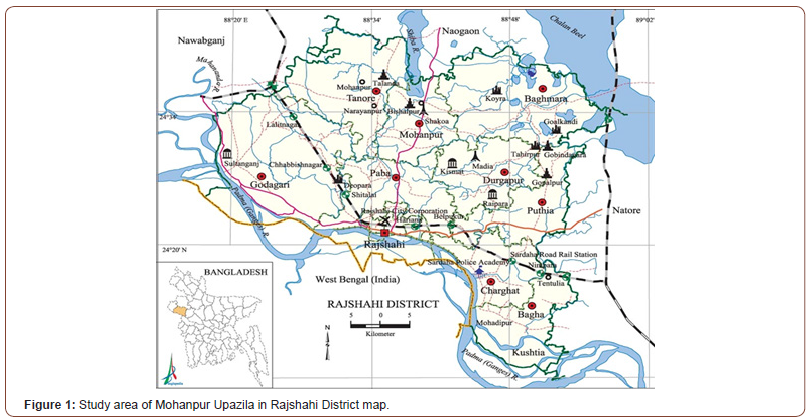
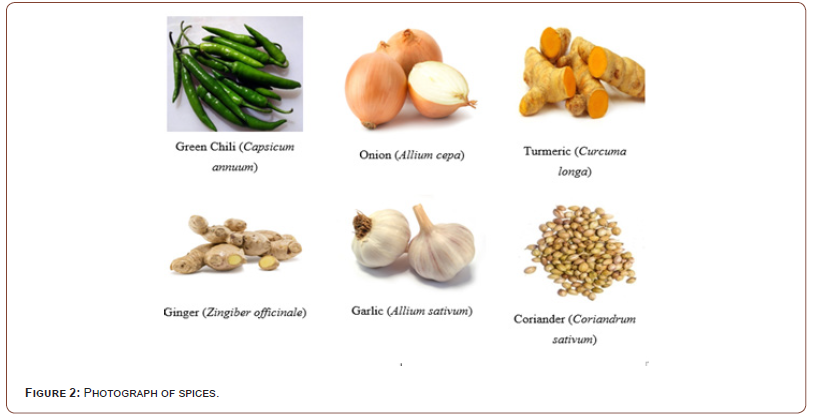
Table 1:Local names, English names, scientific names and family of analyzed spice samples.

Collection and preparation of spices samples
Six (6) different species samples Figure 1 were collected from the field around the Mohanpur Upazila area. A detailed description (English name, scientific name, local name, types of spices etc.) has been presented in Table 1. The samples were thoroughly cleaned first under tap water to remove dust, dirt, possible parasites or the eggs and then washed again with double distilled water (DDW). Non-edible parts were removed according to common household practices and the edible portion was chopped into small pieces. The small pieces of samples were dried in sun. Then it dried an air-dried oven at 90-95°C until a constant weight was obtained. The dried samples were crushed in a grind machine and passed through a 85 mesh sieve. The samples were homogenized by grinding and stored in desiccators in the dark until analysis, usually with the same week [6].
Analysis of spices sample
An investigation is conducted on the status of toxic heavy elements in some rain water samples by using Atomic Absorption Spectrophotometric (AAS) technique. For each digestion, 1 gm of dried power sample was taken into the appropriate digestion vessels. 10 ml of 69% w/w HNO3 and 2 ml of 30% w/w H2O2 were added with sample into digestion vessels (250ml) and the samples were heated continuously at a temperature slowly raised up to 80-100°C until a clear solution was appeared. After cooling the digest solution, it were centrifuged for 2 min at 30 rmp and filtered with filter paper (Whatman no.42). Final volume was made in a 50 ml volumetric flask with double distilled water. Lastly, the digested samples were analyzed by using an atomic absorption spectrophotometer (AAS). Concentration of Pb, Cd, Cr and As in the filtrate of digested spice samples were estimated by using atomic absorption spectrophotometer (GTA 120-AA240Z, Varian, Australia and SpectrAA 220 AAS, Varian, Australia). The instrument was fitted with specific lamp of particular metal. The instrument was calibrated using manually prepared standard solution of respective heavy metals as well as drift blanks. Standard stock solutions of 1000 ppm for all the metals were obtained from Kanto Chemical Co. Inc, Tokyo, Japan. These solutions were diluted for desired concentrations to calibrate the instrument.
Data analysis
Metal pollution index: The MPI (metal pollution index) was
calculated based on the total heavy metal concentration in all spices
tested. This index was calculated by taking the geometrical mean of
all metal concentrations in the spices [7].
MPI = (Cf1 Х Cf2 Х………. Х Cfn)1/n --------(1)
Where Cfn = concentration of metal in the spice samples.
Health risk assessment of spices consumption: The potential
health risks of heavy metal consumption through spices were
assessed using the estimated daily intake (EDI), target hazard
quotient (THQ), and Hazard Index (HI). The EDI value is determined
by the element concentrations in spices, the amount consumed
daily, and body weight. EDI values of the analyzed metals were
estimated based on Eq. (2). [8]
EDI=(C_metal×IR)/BW………………………….(2)
Where, EDI is estimated daily intake and Cmetal (mg/kg) is an average weighted heavy metal content in spices, IR (ingestion rate) is the average daily consumption of spices (gram/day person), BW is the average body weight (Kg) [9]. The average IR of spices for adult is 10 g/day/person of dry weight which is similar to the literature. The average body weight for adult was 60.0 kg [10].
THQ is used to assess the non-carcinogenic risks of long-term
exposure to contaminants in vegetables, and the calculations were
done using Eq (3).
THQ=EDI/RfD……………………(3)
Where, RfD is reference dose values for each metals of interest (mg/kg day_1). The RfD values for Pb. Cd, Cr and As were 0.004, 0.001, 0.003 and 0.0003 mg/kg per day, respectively [11,12].
The HI has been developed to estimate the overall noncarcinogenic
risk to human health through exposure of more than
one pollutant. As shown in Eq. (4), HI is the total of the hazard
quotients all heavy metals in spices.
HI= THQ(Pb) + THQ(Cd) + THQ(Cr) + THQ(As) ……. (4)
If the values of THQ/HI 1 indicate that the population will pose potential adverse health effects, while if THQ/HI < 1, the population is unlikely to experience obvious adverse effect [13-15].
Results and Discussion
Metal concentrations
Lead (Pb): Total lead concentrations in all the spice samples studied through AAS are shown in Table 2. The concentrations are reported as milligrams of total lead per kilogram of edible parts of spice (dry wt. basis). From the results, it has been seen that the concentrations of lead were varied from 0.8504 mg/kg to 1.9694 mg/kg. However, the sequence for Pb concentration in the studied spices was found as Garlic < Green chili < Onion < Turmeric < Coriander < Ginger respectively Figure 3. The maximum permissible limit of lead in foodstuffs is 7.2mg/kg (dry wt. basis) [16]. From the present investigation, it is observed that the concentration of lead is lower than the toxic level. K Gleason et al reported that in Munshiganj District of Bangladesh, lead concentrations as high as 483 ppm in many turmeric samples [17]. Again, according to the FDA report PRAN’s turmeric powder in plastic packages and plastic jars contained lead ranging from 28 ppm to 53 ppm [18]. Recently, TIME reported that, researchers in Boston tested 15 spices and food products imported from Indian and found a quarter of the samples contained more than 1 microgram of lead per gram [19]. CG Lin et al. found twenty-two of 86 spices and foodstuff products contained > 1 μg/g lead (for these 22 samples, mean: 2.6 μg/g [95% confidence interval: 1.9-3.3]; maximum: 7.6 μg/g) [20,21]. About 25% of the food items, including spices such as cardamom, fenugreek and chili powder, contained more than 1 microgram of lead per gram of product. M P Senanayake et al. observed spices sold in Sri Lanka contain lead below the US Food and Drug Administration’s action level of 0.5 μg/g [22]. So, it is concluded that lead content in all the spice samples collected from Mohanpur Upazila are within normal limit. These are safe for human consumption. (Table 2)
Table 2:Concentration of heavy metals in spice sample from Mohanpur Upazila.


Cadmium (Cd): Cadmium is a highly toxic metal that accumulates in the kidneys and liver and can cause a variety of serious diseases even at low concentrations [23-25]. This study reveals that the total Cadmium (Cd) concentration in the studied spices samples remain in the range of 0.1522-1.2173 mg/kg respectively Table 2. However, the sequence for Cd concentration in the studied spics was found as Turmeric < Garlic < Coriander < Onion < Ginger < Green chili respectively Figure 4. The maximum permissible concentration of cadmium in all foods of Bangladesh is 6 mg/kg (dry wt. basis) [26]. Abou-Arab et al. investigated 303 samples, which represent 20 different types of spices and medicinal plants that were collected from Egypt and found maximum levels of Cd 2.44 μg/g [27]. Again, Turkey Divrikli et al. obtained the Cd level 0.2-2.7 μg g−1 among eleven different spices and herbal plants collected western Anatolia [25]. O D Adeyolanu et al. identified that the levels of cadmium contents in the basil leaf are lower than other parts; there could be accumulation of this metal through long-term consumption of the leaf [28]. M Ziyaina et al. investigated cadmium (Cd) concentration in selected spices commonly consumed in Libya and found Cd concentrations for C. frutescens, C. longa and P. nigrum were 0.32 ± 0.04, 0.36 ± 0.09 and 0.35 ± 0.07 mg/kg respectively [29]. The result we obtained from the present analysis indicates that all the spice samples are within the permissible limit in terms of cadmium and they are safe for human consumption.
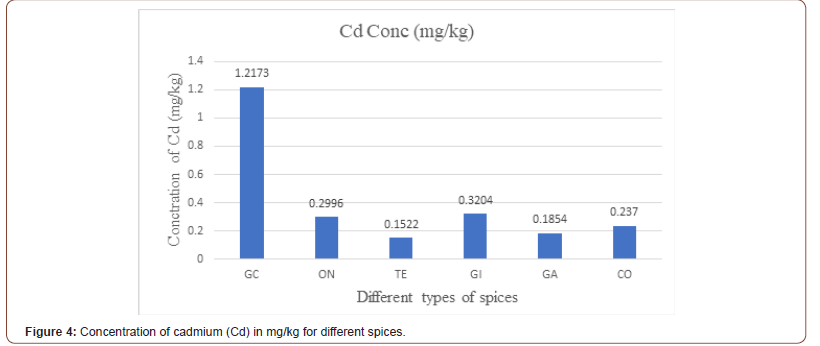
Chromium (Cr): Chromium is a toxic heavy metal which plays important role for physiological and biological functions of the human body when it is below tolerable limits [30]. However, its deficiency causes hyperglycemia and elevated body fat; and high Cr concentration damages kidneys, liver, and blood cells through oxidation reactions [24]. From the results of Table 2, it is seen that the concentrations of chromium in spics samples were varied from 0.7172-1.4760 mg/kg which were bellow than the maximum permissible limit except two samples (Ginger and Garlic). However, the sequence for Cr concentration in the studied spices was found as Onion < Turmeric < Coriander < Green chili < Garlic < Ginger respectively Figure 5. Maximum permitted concentration of chromium in foods is 1 mg/kg recommended by International/ National standards for heavy metals in food [31]. PFA safe limit of chromium for vegetable is 20 mg/kg [32,33]. The chromium content in vegetables and fruits are 0.16679 mg/kg to 1.92625 mg/ kg and 0.513 to 2.5021 mg/kg that are comparable with the values reported by N Saha et al. and E Garcia et al. determined the presence of chromium in a total of 72 samples of 17 different spices and aromatic herbs which are consumed in the Spanish diet and in the Mediterranean diet [34,35] In Egyptian spices and medicinal plants Abou-Arab et al. determined maximum levels of Cr was 33.75 μg/g among a total of 303 samples, which represent 20 different types of spices and medicinal plants [27]. Divrikli et al. found the range of Cr from 0.1 to 9.7 μg/g in eleven different spice and herbal plant species from western Anatolia, Turkey [25].
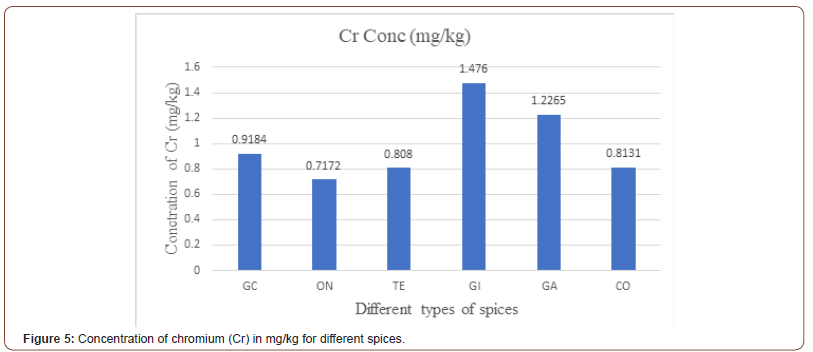
Arsenic (As): From the results of Table 2, it is seen that the concentrations of arsenic in spics samples were varied from 0.5903- 4.0157 mg/kg. The recommended and tolerance limits of arsenic in foodstuffs, water and soil are prescribed as 1.0 mg/kg, 0.05 mg/ kg and 20 mg/kg respectively [36]. However, the sequence for As concentration in the studied spices was found as Onion < Turmeric < Coriander < Garlic < Ginger < Green chili respectively Figure 6. In the present investigation we found that, green chili and ginger possess higher arsenic content than permissible limit. Finally, we can say that the samples of onion, turmeric, garlic and coriander have permissible limit of arsenic for human consumption and green chili and ginger are highly toxic for human consumption. (Figure 3-6)
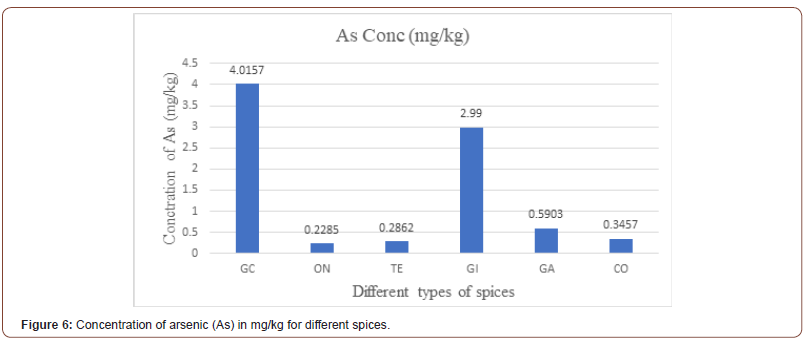
Metal pollution index (MPI)
Calculate metal pollution index (MPI) in different spices samples as shown in Figure 7 followed decreasing sequence of Green chili > Ginger > Garlic > Coriander > Onion > Turmeric respectively. Mahtab et al. (2021) calculate metal pollution index (MPI) in different foodstuffs from Ruppur Nuclear Power plant site in Pabna district, Bangladesh and found the sequence of Bitter gourd (BG) > Pawpaw (PP) > Ceylon Spinach (CS) > Red Amaranth (RA) > Guava (GU) > Mango (MN) > Lady’s Finger (LF) > Brinjal (BR) > Jackfruit (JAC) > Banana (BA) respectively [37]. Jolly et al. (2013) calculate metal pollution index (MPI) in different vegetables from Ruppur Nuclear Power plant site in Pabna district, Bangladesh and found the sequence of BGL > WS > LF > SP > TM > BN > BA > LR > WG > AM > SG > BG > CA > BR > RA > PL > PP > CF > TO respectively [38]. However, from results of MPI, it is obvious that, these spices may cause human health risk due to the higher accumulation of heavy metals.
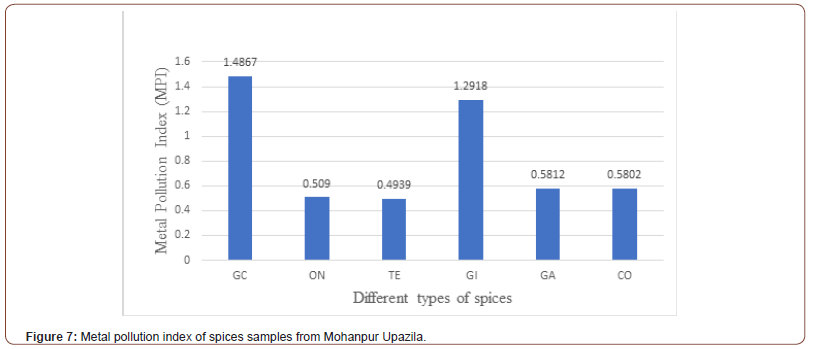
Health risk assessment
As shown in Table 2, the EDI values of Pb Cd, Cr and As were calculated to be 0.000181-0.000328, 0.0000253-0.000202, 0.000134-0.000246 and 0.0000380-0.0000983 respectively. M Tefera et. al. found the EDI values of Cr, Cu and Zn were calculated to be 0.0002-0.0041, 0.0018-0.0270 and 0.0018-0.0090, respectively [8]. The THQ values were ranged from 0.0354-0.0820 for Pb, 0.0253- 0.2028 for Cd, 0.0328-0.0820 for Cr and 0.1269-0.2.2306 for As. The THQ values in all spices were less than one except As in two spices samples (Green Chili and Ginger), indicating that consumption of spices do not impose a potential health risk from As. M Tefera et. al. found The THQ values were ranged from 0.008_1.3805 for Cr, 0.0499-0.1453 for Cu and 0.0062-0.0301 for Zn [8]. It can be seen that 100 % of the HI values due to the consumption of spices were less than one. In general, serious chronic health impact has been suggested when the value of HI is > 10. Therefore, THQ and HI values suggest that the exposed population is assumed to be safe. (Table 3) (Figure 7)
Table 3:EDI, THQ and HI values of heavy metals in different spices from Mohanpur Upazila.

Conclusion
The purpose of this study was to look into the concentrations of various metals in spices. Metals analysis in spices was performed using the optimized wet digestion method. On the basis of the present results it can be concluded that the spices collected from Mohanpur upazila area of Rajshahi district are safe to eat except Green chili, Ginger and some of Garlic. The possible reason of high chromium and arsenic content in spices may be soil nature, irrigated ground water quality, fertilizer and pesticide quality. The difference in the content of metals in each spice may be attributed the difference in soil types and agricultural inputs. The MPI (metal pollution index) value for Green chili, Onion, Turmeric, Ginger, Coriander and Garlic is generally low to spices analyzed. The results of the present study indicate that As is the only metal in two spices (Green chili and Ginger) slightly contributes non-carcinogenic risk from the point of view of THQ. In general, the findings of the study show low health risk of the metals Pb, Cd and Cr through consumption of these spices. Finally, it is suggested that constant monitoring of heavy metals is needed on all food commodities in order to evaluate health risks from toxic heavy metal and protect the consumer.
Acknowledgement
The authors are deeply thankful to Central Science Laboratory of Rajshahi University, Rajshahi for providing all necessary research facilities.
Conflict of Interest
Author declare no conflict of interest
References
- Thomas F, Daoust SP, Raymond M (2012) Can we understand modern human without considering pathogens. Evolu appli 5(4): 368-379.
- Gupta KK, Bhattacharjee S, Kar S, Chakrabarly S, Thakar P (2003) Investigation of heavy metals in commercial brands. Commu Soil Sci and Plant Analy 34: 681- 693.
- Bakhru HK (2003) Herbs that Heal: Natural Remedies for Good Health. Orient Paper Backs Vision Blood put Limited. New Delhi.
- Sherman WP, Billing J (1998) Antimicrobial functions of spices: why some like it hot. Q Rev Biol 73(1): 3-49.
- Mubeen H, Naeem I, Taskeen A, Saddiqe Z (2009) Investigations of heavy metals in commercial spices brand. New York Science Journal 2(5).
- Rahman MS, Hossain MB, Babu SMOF, Rahman M, Ahmed ASS (2019) Source of metal contamination in sediment, their ecological risk, and phytoremediation ability of the studied mangrove plants in ship breaking area, Bangladesh. Marine Pollution Bulletin 141: 137-146.
- Usero J, Gonzalez ER, Gracia I (1997) Trace Metals in Bivalve Mollusks Ruditapes decussates and Ruditapes philippinarum from the Atlantic Coast of Southern Spain. Environment International 23(3): 291-298.
- Tefera M, Teklewold A (2021) Health risk assessment of heavy metals in selected Ethiopian spices. Heliyon 7(5): e07048.
- Amer M, Sabry B, Marrez D, Hathout A, Fouzy A (2019) Exposure assessment of heavy metal residues in some Egyptian fruits. Toxicology Reports 6: 538-543.
- Meseret M, Ketema G, Kassahun H (2020) Health risk assessment and determination of some heavy metals in commonly consumed traditional herbal preparations in Northeast Ethiopia. Jou Chem pp. 1-7.
- USEPA (2011) Risk-based Concentration Table, United State Environmental Protection Agency, Washington, USA.
- Gebeyehu HR, Bayissa LD (2020) Levels of heavy metals in soil and vegetables and associated health risks in Mojo area, Ethiopia. PloS One 15(1): e0227883.
- Ghasemidehkordi B, Malekirad A, Nazem H, Fazilati M, Salavati H, et al. (2018) Concentration of lead and mercury in collected vegetables and herbs from Markazi province, Iran: a noncarcinogenic risk assessment, Food Chem. Toxicol. 113: 204-210.
- Khan S, Farooq R, Shahbaz S, Khan M, Sadique M (2009) Health risk assessment of heavy metals for population via consumption of vegetables. World Appl Sci J 6(12): 1602-1606.
- Mohammadi A, Zarei A, Majidi S, Ghaderpouryd A, Hashempour Y, et al. (2019) Carcinogenic and non-carcinogenic health risk assessment of heavy metals in drinking water of Khorramabad, Iran. MethodsX 6: 1642-1651.
- ANHMRC (1987) Australian National Health and Medical Research Council.
- Gleason K, Shine JP, Shobnam N, Rokoff LB, Suchanda HS, et al. (2014) Contaminated Turmeric Is a Potential Source of Lead Exposure for Children in Rural Bangladesh. J Environ Public Health 2014: 730636.
- http://www.thedailystar.net/news/us-recalls-pran-turmeric-powder; Accessed on 16 December 2017.
- http://www.foodsafetynews.com/2010/03/spice-regulation-facing-renewed-scrutiny/#.WjUXYXlxXIU; Accessed on 16 December 2017.
- Lin CG, Schaider LA, Brabander DJ, Woolf AD (2009) Pediatric Lead Exposure from Imported Indian Spices and Cultural Powder. Pediatrics 125(4): e828-835.
- http://content.time.com/time/health/article/0,8599,1971906,00.html; Accessed on 16 December 2017.
- Senanayake MP, Perera R, Liyanaarachchi LA, Dassanayake MP (2013) Spices as a source of lead exposure: a market-basket survey in Sri Lanka. Ceylon Med J 58(4): 168-169.
- Batool S, Khan N (2014) Estimation of heavy metal contamination and antioxidant potential of Pakistani condiments and spices. J Biodiv Environ Sci 5(3): 340-346.
- Dagne B, Endale T, Tesfahun K, Negash D (2019) Levels of some toxic heavy metals (Cr, Cd and Pb) in selected vegetables and soil around eastern industry zone, central Ethiopia. Afr J Agric Res 14(2): 92-101.
- Divrikli U, Horzum N, Soylak M, Elci L (2006) Trace heavy metal contents of some spices and herbal plants from western Anatolia, Turkey. International journal of food science and technology 41(6): 712-716.
- Rayment GE Australian and Some International Food Standards for Heavy Metals, Queensland Department of Primary Industries.
- Abou-Arab AAK, Abou Donia MA (2000) Heavy Metals in Egyptian Spices and Medicinal Plants and the Effect of Processing on Their Levels. J Agric Food Chem 48(6): 2300-2304.
- Adeyolanu OD, Kadiri OJ, Are KS, Oluwatosin GA, Moral MT (2016) Lead and cadmium contents in a medicinal plant/spice grown in an urban city of Nigeria. Cogent Food & Agriculture 2(1): 1136016.
- Ziyaina M, Rajab A, Alkhweldi K, Algami W, Toumi AO, et al. (2014) Lead and cadmium residue determination in spices available in Tripoli City markets (Libya). African J of Biochem Research 8(7): 137-140.
- Lakshmanasenthil S, Vinothkumar T, Kumar T, Marudhupandi T, Veettil D, et al. (2013) Harmful metals concentration in sediments and fishes of biologically important estuary, Bay of Bengal. J Environ Health Sci Eng 11(1): 33.
- Choi DYY (2011) International/ National Standards for Heavy Metals in Food. Chemist Government Laboratory.
- Varalakshmi LR, Ganeshamurthy AN (2010) Heavy metal contamination of water bodies, soils and vegetables in peri urban areas of Bangalore city of India. 19th World Congress of Soil Science, Soil Solutions for a Changing World, Brisbane Australia.
- Gupta N, Khan OK, Santra SC (2008) An Assessment of Heavy Metal Contamination in Vegetables Grown in Wastewater-Irrigated Areas of Titagarh, West Bengal, India. Bull Environ Contam Toxicol 80(2): 115-118.
- Saha N, Zaman MR (2012) Heavy metals in fishs, fruits and vegetables from Rajshahi, Bangladesh: A Statistical Approach. J of Nature Sci and Sustain Techno 6(3): 238-253.
- Garcia E, Cabrera C, Lorenzo ML, López MC (2000) Chromium levels in spices and aromatic herbs. Sci Total Environ 247(1): 51-56.
- Anon (1987) Codex Alimentarius Commission- Report of the seventeenth session, 29 June-10 July FAO/WHO, Rome.
- Mollah MMA, Rakib-uz- Zaman M, Salam SMA, Rahman MS (2021) Health Risk Assessment of Heavy Metals Through Ten Common Foodstuffs Collected from an Area of Ruppur Nuclear Power Plant, Pabna, Bangladesh. Global Journal of Nutrition & Food Science 3(4): 1-11.
- Jolly YN, Akter S, Kabir J, Islam A (2013) Health risk assessment of heavy metals via dietary intake of vegetables collected from an area selected for introducing a Nuclear Power Plant. Research Journal of Physical and Applied Sciences 2(4): 043-051.
-
Md. Mahtab Ali Mollah*, Md. Golam Rabbany, M Nurunnabi, Sha Md.Shahan Shahriar and Sayed M A Salam. Health Risk Assessment of Heavy Metals Through Six Common Spices of Mohanpur Upazila of Rajshahi District, Bangladesh. Glob J Nutri Food Sci. 3(5): 2022. GJNFS. MS.ID.000574.
-
Heavy Metal, Spices, Health Risk, Oral Reference Doses, Flavouring, Colouring, Preserving food, High blood pressure, Fatigue, Kidney, Neurological disorder, Human foetus, Abortion, Preterm labour, Dust, Dirt, Possible parasites
-

This work is licensed under a Creative Commons Attribution-NonCommercial 4.0 International License.






